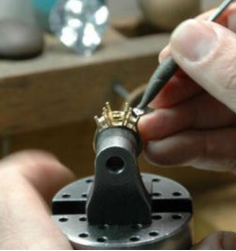The Process flow of our 925 Sterling Silver Jewelry2020-07-29
(1) Freehand Design: The designer makes freehand sketches according to their own conception, marks the size and other data then completes the original design drawings.
(2)CAD Modeling: According to the design drawings, the modeler uses CAD software to carry out accurate structural design, size planning and placement of inlaid stone for each part of the jewelry. The finished CAD drawing can be used for computer wax carving, and can also be used for customers to confirm the customized form.
(3) Wax Spraying by Computer: Computer wax carving machine engraves wax plates according to CAD modeling files.
(4) Inverted Mold: including plaster pouring, plaster baking, dewaxing, gold melting, casting and other steps then lost wax casting silver plate.
(5) Production of Film: the silver plate is pressed with rubber, and the film is obtained after mold opening.
(6) Wax Injection: Wax injection machine is used to inject wax into the film, and wax film is produced in batches.
(7) Wax Setting: To set on wax film.
(8) Modify Wax Film and Plant Wax Trees
(9) Lost Wax Casting: The procedure is the same as the inverted mold. The purpose of this procedure is to produce the mold.
(10) Mold Holding: After losing wax casting, problems such as sand hole, heavy edge, sag and fracture will occur on the surface of the mold, which need to be repaired and corrected.The main steps include welding and repair welding, file proper use, sandpaper and rubber wheel use, typing and so on.

(11) Hand Inlaying: Usually, the main stone of large size or high-temperature refractory stone will be inlaid by hand on the mold.There are several different types of tessellations, described in more detail later.

(12) Surface Treatment Before Electroplating: including bright treatment, oil removal treatment and etching treatment.
Bright processing: also call polishing, at present the most commonly used is mechanical polishing, generally according to the first rough cast after the steps of fine polishing, when polishing wheel high-speed rotation, jewelry and polishing wheel and molten polishing wax between the high temperature, so that the metal plastic improve, surface fine uneven to improve, gloss increase.
Degreasing treatment: The polished jewelry will have wax and oil on the surface, so it needs degreasing treatment.Common methods include electric oil removal and chemical oil removal + ultrasonic cleaning.
Etch treatment: although noble metal has good oxidation resistance, but the surface will still form oxide layer, do not remove the oxide layer will affect the plating effect.In etching treatment, inorganic acid is used to remove the oxide layer on the plating surface to ensure a good combination between the plating layer and the substrate.
(13) Electroplating treatment: According to the metal plating can be divided into rhodium plating (also called platinum plating), 14K gold plating (K yellow plating), 18K gold plating (rose gold plating).No matter what kind of metal is electroplated, the common standard is nickel free electroplating.
Rhodium Plating: can make jewelry white color, wear - resistant, not easy oxidation color.The conventional plating thickness is 0.02-0.03μm, and the thickened plating thickness is 0.05-0.075-0.1μm.Because the rhodium plating stability is good, the conventional plating thickness can be used.
14K Gold Plating: gold color on the surface of jewelry, stability is lower than rhodium plating and higher than 18K gold plating.Conventional plating thickness of 0.025 to 0.04μm, thickening plating thickness of 0.25-0.5-0.75-1-1.25-1.5-2-3-4-5μm.Since 14K gold is not as stable as rhodium, there is a risk of oxidation and discoloration in the thickness of conventional electroplating. Thicker coating or electrophoretic protective layer can be used to prevent discoloration.
18K Gold plating: the surface of the jewelry appears rose gold color, the color of rose gold can be adjusted according to customer requirements.The normal plating thickness is 0.025-0.04μm, and the thickened plating thickness is 0.25-0.5-0.75-1μm.Compared with rhodium and 14K gold, 18K gold is the most unstable and prone to oxidation and discoloration, so a thick electroplating or electrophoretic coating is usually required to prevent discoloration.
More fine jewelry please kindly browse our website and give us your valuable suggestion!
Xiamen Michelson Import and Export Co.,Ltd.
Unit 1205,No.66,Ninghai Yili,Jimei District,Xiamen
China Sales Respresentative - Grace
WhatsApp:(+86)18859224669
Email: info@xmcrafts.com
Phone 1: (+0086) 188 5922 4669
Phone 2: (+0086) 156 5998 5069
